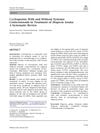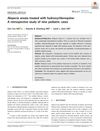TLDR The treatment helped some patients with severe hair loss regrow hair.
In a study involving nine patients with alopecia areata, researchers tested a combination of oral psoralen and ultraviolet A (PUVA) therapy with oral prednisolone. The participants, who had previously not responded to other treatments, included six with alopecia totalis and three with alopecia universalis. After 3 months, seven patients showed greatly increased hair growth, while two showed moderate growth. The control group, which only received prednisolone, had significantly lower hair growth scores. The study suggested that the treatment might restore T regulatory cell function, contributing to hair regrowth. However, it remained unclear if PUVA alone would be effective without prednisolone.
24 citations
,
March 2009 in “Archives of dermatological research” The combination of oral PUVA and corticosteroids helps regrow hair in severe alopecia areata.
 13 citations
,
April 2020 in “Dermatology and therapy”
13 citations
,
April 2020 in “Dermatology and therapy” Cyclosporine combined with corticosteroids is more effective for severe alopecia areata than cyclosporine alone.
 17 citations
,
March 2018 in “Pediatric dermatology”
17 citations
,
March 2018 in “Pediatric dermatology” Hydroxychloroquine may help treat alopecia areata in children.
1 citations
,
March 2017 in “PubMed” Topical minoxidil did not significantly regrow hair in alopecia areata patients after 3 months.
 14 citations
,
January 2011 in “International Journal of Trichology”
14 citations
,
January 2011 in “International Journal of Trichology” Some people with severe, long-lasting baldness responded well to a specific combination treatment.
1 citations
,
January 2004 Low-dose intermittent corticosteroid therapy can effectively treat alopecia areata.
30 citations
,
August 1998 in “International Journal of Dermatology” Systemic corticosteroids don't prevent severe alopecia areata from spreading or relapsing.
105 citations
,
December 1995 in “British journal of dermatology/British journal of dermatology, Supplement” PUVA treatment is generally ineffective for alopecia areata.
31 citations
,
January 1981 PUVA-therapy is not very effective for severe hair loss types like alopecia totalis or universalis.


